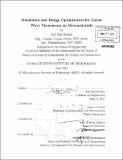| dc.contributor.advisor | Jaume Peraire and Ngoc-Cuong Nguyen. | en_US |
| dc.contributor.author | Saà-Seoane, Joel | en_US |
| dc.contributor.other | Massachusetts Institute of Technology. Computation for Design and Optimization Program. | en_US |
| dc.date.accessioned | 2011-08-18T19:18:44Z | |
| dc.date.available | 2011-08-18T19:18:44Z | |
| dc.date.copyright | 2011 | en_US |
| dc.date.issued | 2011 | en_US |
| dc.identifier.uri | http://hdl.handle.net/1721.1/65323 | |
| dc.description | Thesis (S.M.)--Massachusetts Institute of Technology, Computation for Design and Optimization Program, 2011. | en_US |
| dc.description | Cataloged from PDF version of thesis. | en_US |
| dc.description | Includes bibliographical references (p. 87-91). | en_US |
| dc.description.abstract | Periodicity can change materials properties in a very unintuitive way. Many wave propagation phenomena, such as waveguides, light bending structures or frequency filters can be modeled through finite periodic structures designed using optimization techniques. Two different kind of problems can be found: those involving linear waves and those involving nonlinear waves. The former have been widely studied and analyzed within the last few years and many interesting results have been found: cloaking devices, superlensing, fiber optics The latter is a topic of high interest nowadays and a lot of work still needs to be done, since it is far more complicated and very little is known. Nonlinear wave phenomena include acoustic amplitude filters, sound bullets or elastic shock mitigation structures, among others. The wave equation can be solved accurately using the Hybridizable Discontinuous Galerkin Method both in time and in frequency domain. Furthermore, convex optimization techniques can be used to obtain the desired material properties. Thus, the path to follow is to implement a wave phenomena simulator in 1 and 2 dimensions and then formulate specific optimization problems that will lead to materials with some particular and special properties. Within the optimization problems that can be found, there are eigenvalue optimization problems as well as more general optimal control topology optimization problems. This thesis is focused on linear phenomena. An HDG simulation code has been developed and optimization problems for the design of some model devices have also been formulated. A series of numerical results are also included showing how effective and unintuitive such designs are. | en_US |
| dc.description.statementofresponsibility | by Joel Saà-Seoane. | en_US |
| dc.format.extent | 91 p. | en_US |
| dc.language.iso | eng | en_US |
| dc.publisher | Massachusetts Institute of Technology | en_US |
| dc.rights | M.I.T. theses are protected by
copyright. They may be viewed from this source for any purpose, but
reproduction or distribution in any format is prohibited without written
permission. See provided URL for inquiries about permission. | en_US |
| dc.rights.uri | http://dspace.mit.edu/handle/1721.1/7582 | en_US |
| dc.subject | Computation for Design and Optimization Program. | en_US |
| dc.title | Simulation and design optimization for linear wave phenomena on metamaterials | en_US |
| dc.type | Thesis | en_US |
| dc.description.degree | S.M. | en_US |
| dc.contributor.department | Massachusetts Institute of Technology. Computation for Design and Optimization Program | |
| dc.identifier.oclc | 746081128 | en_US |
